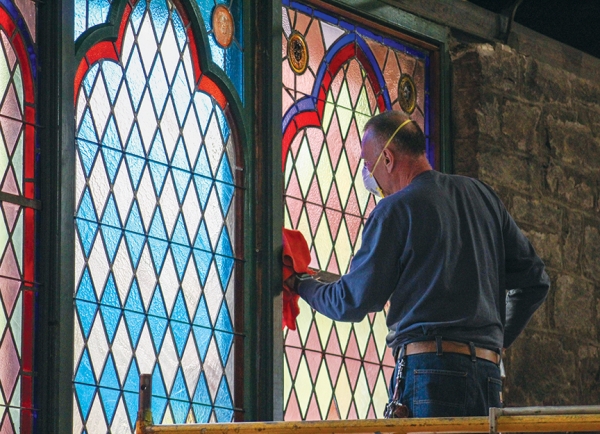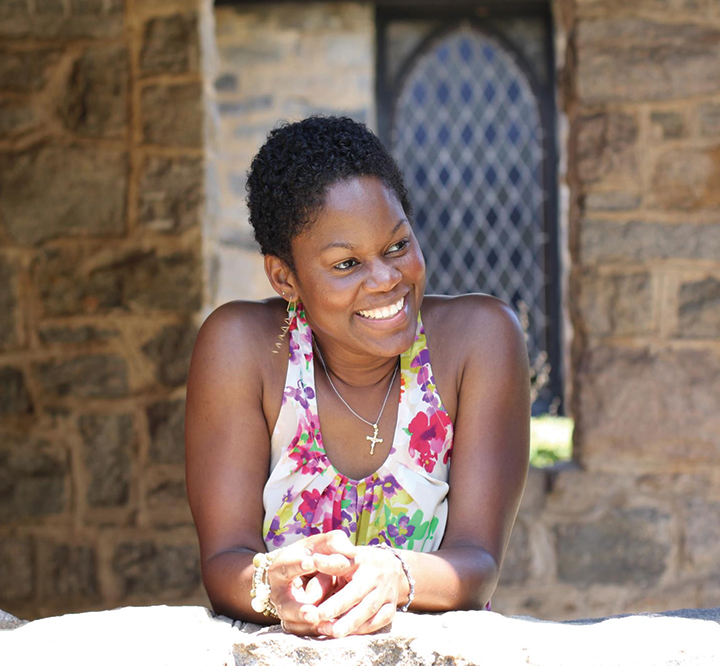Disciple: Lifting as They Climb

The Chapel at Saint Augustine’s University enters a new era
The oldest building on campus, the Chapel at Saint Augustine’s University has stood as a cornerstone of faith and community in the heart of Raleigh for more than a century. The Chapel was built in 1895, and, from the start, students have been more than mere attendees of the church, quarrying the stone for construction under the supervision of quarry master, masonry instructor and future bishop suffragan of the Diocese of North Carolina the Rev. Henry Beard Delany.
If the Chapel’s historic roots provide its foundation, they also continue to enrich and support its ongoing growth. Recently awarded a $18,686 United Thank Offering grant, the Chapel used this latest grant with others it received for the restoration of the stained-glass windows and pews, the creation of an outdoor worship space and retrofitting the building for modern technology. The work on the windows was completed earlier this year, and the pews and new outdoor space will receive attention in the coming months. The UTO grant provided for the next steps forward, as work recently began on upgrades to the building to give it the capacity to livestream and offer online worship.
A CONTINUING TRADITION
 One of the factors in the Chapel’s legacy of strength and endurance has been the leadership of the chaplains charged with its care. That tradition continues today with the Rev. Hershey Mallette Stephens (pictured), current dean of the Chapel and spiritual life.
One of the factors in the Chapel’s legacy of strength and endurance has been the leadership of the chaplains charged with its care. That tradition continues today with the Rev. Hershey Mallette Stephens (pictured), current dean of the Chapel and spiritual life.
Many readers may recognize her name, as Mallette Stephens has been a part of the Diocese of North Carolina community all her life. Raised in Raleigh, she grew up a member of St. Ambrose, Raleigh, and, in her new position as dean of the Chapel, she continues a decades-old tradition of family connection to Saint Augustine’s University. Her grandfather taught at Saint Augustine’s, and her father attended the university in his own time. “I’m the third generation to be part of the Saint Augustine’s family,” said Mallette Stephens. “That is such a privilege, and also it feels like a responsibility as the school is trying to navigate the challenges of this time. [But] it’s had its challenges in every generation, and it makes me feel like God is not done at Saint Augustine’s.”
IT STARTS WITH THE STUDENTS
God may still have plans for Saint Augustine’s, but it is not work Mallette Stephens will do alone. As always, the students are at the heart of university life, including the life of the Chapel.
“My students are great,” said Mallette Stephens. “The junior class president is an Episcopal student, and they’re all leaders on campus. Several are student ambassadors and do the student orientation. I’ve got about eight of them on the president’s honor college. They’re great students and give back to the university and watch out for each other. I really appreciate and admire that.”
Many of the students most active in the Chapel right now come from an Anglican-Episcopal background, and several hail from the Bahamas and Honduras. For them, the international travel required to go home has added an additional layer of isolation in the last year, as many of those students have not been able to go home during the pandemic. But they are never left to feel alone, as Mallette Stephens checks in regularly with them to ensure they are doing well and have what they need.
That she has connected so quickly with her students is a testament to Mallette Stephens’ ability and drive. She started her tenure only in the spring of 2020, her start date followed shortly by the birth of her first child. COVID-19 and its subsequent challenges came only a few weeks after that, taking with it the most common ways a new chaplain connects with students.
But COVID-19 didn’t stop Mallette Stephens. Taking advantage of technology, she began creating Sunday Morning Prayer services and involving the students already active with the Chapel. “We [did it] with our phones,” she said. “The students recorded themselves doing the readings, I recorded my message and we spliced it all together.” She has even had faculty guest preachers be part of it; Dr. Josiah Sampson, III, provost and vice president of academic affairs, recently preached the closing sermon.
When the weather was warmer, they also took advantage of “The Yard,” the large, grassy expanse between the Chapel and Oakwood Avenue. On a few summer days, students could be found playing socially distanced games of croquet and badminton. As the weather holds, “Mass on the Grass” services have also provided spiritual bolsters, with students continuing to watch Morning Prayer via video and then meeting for a drive-by-style communion in The Yard.
“It’s been great,” said Mallette Stephens. “Because I’m new, this fall has given me an opportunity to see the students’ faces in the same place so I can touch base and see how they’re doing.”
A SACRED COMMUNITY SPACE
Her dream, though, is to use the new livestreaming capabilities provided by the UTO grant to re-introduce the Chapel as a center for both the on-campus and surrounding communities. In days past, the Chapel was a central part of university life, serving as the gathering place for baccalaureates and lectures. And, of course, everyone worshiped at the Chapel: faculty, staff and students. In the case of students, especially, “it was just a part of the university life,” said Mallette Stephens. “Many of the older alumni still talk about going to chapel. It’s how a lot of African Americans were exposed to and became members of The Episcopal Church.”
Stephens hopes to open the doors of the Chapel, figuratively and literally, to expand the ways it can host and be home to its community. With the new livestreaming capacities, she wants to offer it to university staff as a hybrid online/in-person classroom space, perhaps as early as January.
“This is one of the largest spaces on campus, and we can make this a virtual classroom and worship space,” said Mallette Stephens. “Most of the time, churches get used one day a week, and I’m thinking about ways we can make the chapel a larger part of our life together at Saint Augustine’s. [The Chapel itself] is a beautiful stone, Gothic building, but how do we change the atmosphere around it?
I’m thinking about how—after COVID—to welcome people in. Do we have to be a Sunday morning congregation? COVID has made it so that the convention and order of things don’t necessarily have to be that way. We could be a Thursday evening congregation, and people who maybe go somewhere else on Sunday morning might want to come and do something different and interesting on Thursday evening. I would love to hold and livestream community conversations in the Chapel and have folks come and talk about faith and race and all the things we’re all wrestling with in this time.
We’re learning more things about what buildings can do and how we can stretch and be flexible. It’ll be interesting to see the sacred space hold learning, which itself is sacred and a real privilege. I’m really hopeful [the retrofitting] will give us the capacity to reach out in new and different ways.”
DOING IT TOGETHER
The students will be a part of it all, whether through offering feedback in passing exchanges on campus or in deeper conversations during the office hours Mallette Stephens and deacon the Rev. Sallie Simpson maintain even now. It may even be through service on the student-led vestry currently in development. “I want it to be a place where students have input on how we worship,” said Stephens. “I want it to reflect the style and culture of the student body. I’m still just trying to be curious and figure out what is important to our students and how we might be most helpful.”
Her hope is the more people spend time in the space, the more the students put it on their beaten path, the more they will come to know it is their chapel.
“My students are just wonderful people, and I’m excited to see what they will do,” said Mallette Stephens. “They’re focused and want to give back to their com- munities both here and back home. I really do count it a privilege to join my grandfather and my dad in the legacy of Saint Augustine’s, working with students who are community minded and embody the spirit on which Saint Augustine’s was founded, who are lifting as they climb.”
Christine McTaggart is the communications director for the Diocese of North Carolina.
Tags: North Carolina Disciple
